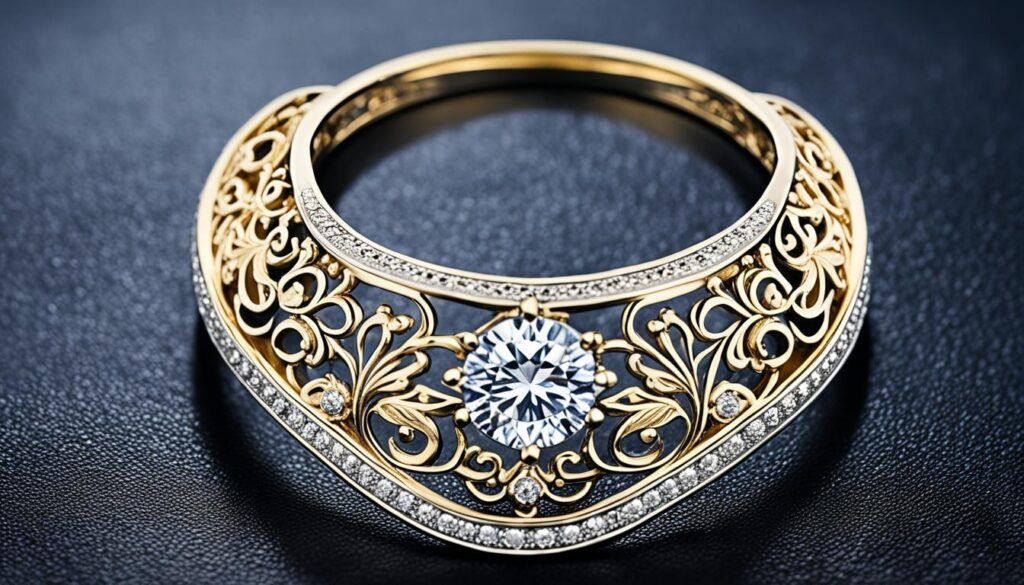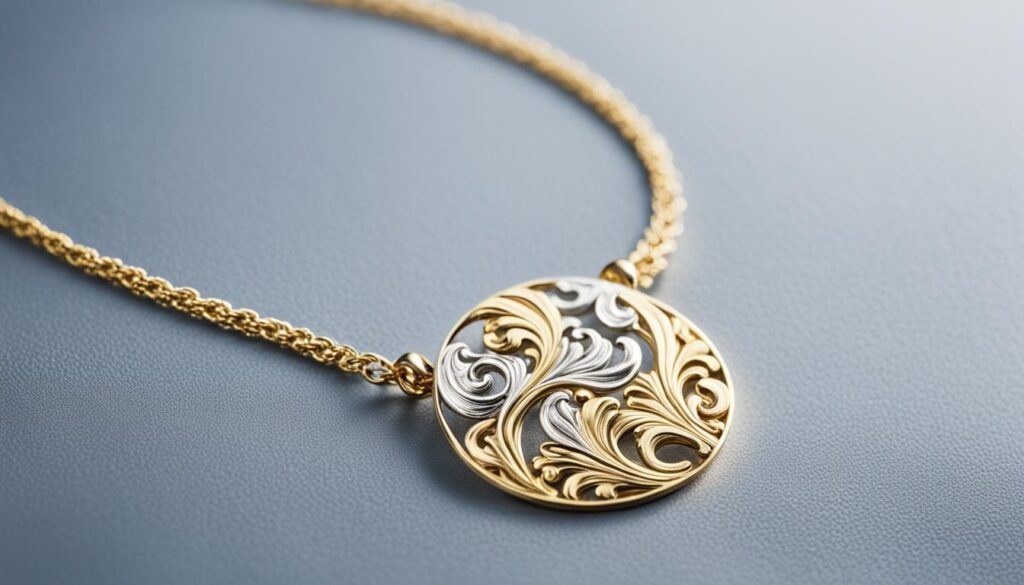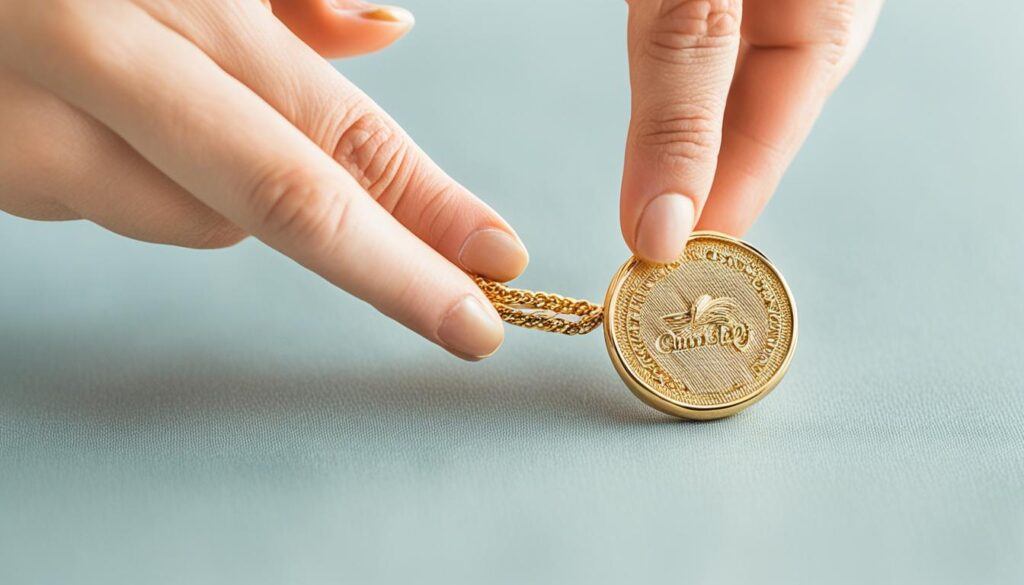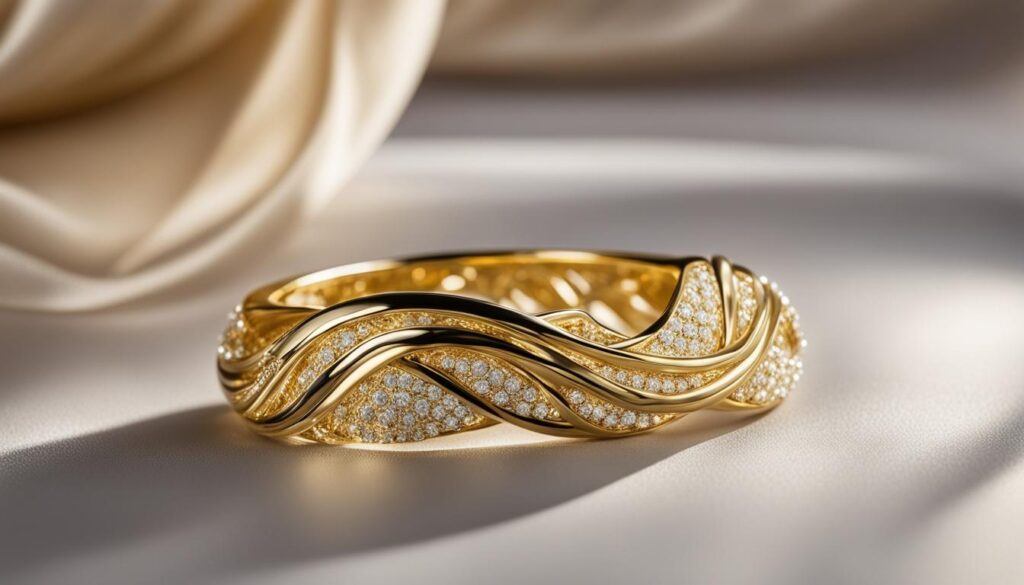When it comes to the intriguing world of jewelry, here’s a twinkling fact that often goes unnoticed: the lustrous finish of gold plated sterling silver can journey through time gracefully for years, given it’s caressed with proper care. The alliance of 92.5% pure silver and a mesmerizing layer of gleaming gold translates gold plated sterling silver longevity into a long but finite tale of beauty and affordability. Indeed, it’s the meticulous gold plating maintenance that holds the pen when scripting the lifespan of gold plated jewelry. As I explore the lasting charm of these adorned treasures, it’s the embodiment of durability harmonized with delicate preservation that transpires into enduring wear.
Key Takeaways
- Understand that 925 sterling silver forms the durable backbone of gold plated jewelry.
- Discover how the thickness and quality of gold plating can dictate the jewelry’s longevity.
- Learn necessary gold plating maintenance techniques to prolong the jewelry’s life.
- Grasp how proper storages shields your treasured pieces from premature wear.
- Recognize the signs to anticipate when your gold plated jewelry may need attention or re-plating.
The Composition and Durability of Sterling Silver
As someone deeply fascinated by the artistry and science of jewelry, I’ve come to learn that sterling silver composition and its durability play a crucial role in its allure. Silver in its purest form is soft, and to enhance its strength for jewelry making, it’s alloyed with other metals. The standard, known as 925 sterling silver, comprises 92.5% pure silver and the remainder often consists of copper, which contributes to its resilience.
Understanding 925 Sterling Silver
The meticulous blend of 92.5% silver with 7.5% of other metals endows sterling silver with the perfect balance of malleability and durability. This hardy alloy is beloved for its luster and longevity, making it a staple in jewelry boxes worldwide.

Factors Influencing Sterling Silver Longevity
Several factors can impact the longevity of sterling silver. The metal’s quality, the craftsmanship behind the jewelry, and even daily wear can affect its condition. Sterling silver may be resilient, but it’s not indestructible. It can succumb to scratches and tarnish over time due to exposure to air and various substances. Adhering to care tips for gold plated jewelry and sterling silver items alike, such as keeping them away from harsh chemicals like chlorine and engaging in regular, gentle cleaning, can help extend their life.
Sterling Silver: Beyond the Surface
Looking beyond mere appearances, sterling silver’s true value lies in its enduring nature. Despite potential surface changes like scratches or tarnish, this metal can retain its quality for years and even be passed down through generations. With focused care and maintenance, this material continues to be a preferred choice for designers and collectors alike who value both beauty and endurance.
Whether it’s sterling silver or gold plated adornments, paying attention to proper upkeep, storing items carefully, and avoiding damaging elements are crucial measures for anyone wishing to preserve the splendor of their treasured pieces.
Defining Gold Plating on Sterling Silver
When it comes to enhancing the elegance and value of sterling silver jewelry, the gold plating process plays a pivotal role. As an enthusiast for luxury yet affordable accessories, I’m always fascinated by the rich gleam of gold plated sterling silver. The allure not only lies in its visual appeal but also in the intricate methods that give it life.
The Gold Plating Process
The process of gold plating over sterling silver typically begins with the thorough cleaning of the silver piece to remove any impurities that could interfere with the adhesion of the gold layer. Various methods such as electroplating are then employed to fuse a thin layer of gold onto the jewelry. The meticulous gold plating process ensures that each piece achieves the desired luster that resonates with the opulence of solid gold while remaining accessible.

Varying Thickness of Gold Layers
The thickness of the gold layers can significantly influence the durability and appearance of the jewelry. Generally, a thicker gold coating might last longer and resist wear better than a thinner one. Let me draw your attention to a comparison of different plating thicknesses, their estimated longevity, and their efficacy in maintaining the sheen that so many of us admire:
| Thickness of Gold Layer | Longevity Estimate | Tarnish Resistance |
|---|---|---|
| 0.5 Microns | Short-term | Low |
| 1 Micron | Medium-term | Medium |
| 2.5 Microns | Long-term | High |
Above all, understanding the effects of the gold plating process and the properties bestowed by various thicknesses of gold layers can empower us to make more informed decisions when selecting our next treasured piece of jewelry.
Maintenance: Maximizing the Lifespan of Gold Plated Jewelry
As an enthusiast of elegant accessories, I understand the importance of gold plated jewelry maintenance and the role it plays in the longevity of gold plated items. Ensuring that these precious pieces retain their sparkle and allure involves a few key practices that help in preventing tarnish on gold plated silver. Let me share the insights and methods I’ve gathered to keep your jewelry looking its best.

To begin with, the golden rule is to avoid harsh chemicals. Substances like chlorine, perfumes, and even harsh soaps can damage the gold layer. Activities such as swimming, cleaning, and showering should be done without wearing your gold plated treasures. This preventive measure goes a long way in safeguarding against unwanted tarnish and erosion of the plating.
Regular yet gentle cleaning is critical. I suggest wiping your gold plated pieces with a soft, lint-free cloth after every wear. This not only removes accumulated oils and potential contaminants but also maintains the sheen that makes gold so captivating. When dirt builds up, a simple solution of warm water and mild soap applied with a soft brush works wonders—just remember to dry the jewelry completely afterwards with a soft cloth.
- Remove jewelry before physical activity to prevent scratches and impact damage.
- Store gold plated jewelry separately in soft-lined compartments or pouches.
- Keep jewelry away from direct sunlight and heat sources, as this can accelerate tarnish.
| Maintenance Task | Frequency | Tips for Optimal Care |
|---|---|---|
| Gentle Wiping | After each wear | Use a soft, dry cloth to remove oils and residues. |
| Deep Cleaning | As needed | Mild soap and warm water; use a soft brush for crevices. |
| Storage | Post-wear | Separate compartments, away from sunlight and heat. |
We wear jewelry as an expression of self and sentiment; by investing time in proper care, we ensure that the beauty and stories they carry can be enjoyed for years to come.
External Factors Impacting Gold Plated Sterling Silver
As we explore the resiliency of gold plated sterling silver, it’s important to recognize that chemical exposure and physical wear are pivotal in determining the longevity of these cherished items. Gold plating, while offering aesthetic elegance, is a thin veil susceptible to environmental influences, which can potentially lead to the tarnishing of gold plated items. Understanding these external pressures helps us mitigate risks and preserve the lustrous appeal of our jewelry.
Chemical Exposure and Tarnishing
The allure of gold plated jewelry can quickly diminish when exposed to harsh chemicals. Common culprits like perfumes, lotions, and cleaning agents contribute significantly to chemical exposure to gold plated jewelry. These substances have the potential to strip away the gold layer, exposing the sterling silver beneath to elements that can hasten tarnish. Knowing what to avoid can be just as important as how we care for our jewelry.
Physical Wear and Environmental Elements
Beyond the chemical risks, physical wear plays a substantial role in the integrity of gold plated jewelry. Daily activities can lead to scratches and gradual wear, revealing the silver underneath sooner than expected. Moreover, the environmental impact on gold plated silver isn’t negligible – humidity, salt air, and even exposure to sulfur in the air can accelerate the tarnishing process. It’s these everyday encounters with the environment that often go unnoticed yet have tangible effects on our jewelry’s durability and appearance.
| Factor | Impact on Gold Plating | Preventative Measures |
|---|---|---|
| Chemicals (Cosmetics, Cleaners, etc.) | Causes fading and tarnish | Avoid contact with jewelry |
| Physical Wear (Scratches, Friction) | Leads to removal of gold layer | Handle with care; remove during physical activities |
| Environmental Elements (Humidity, Salt, Sulfur) | Accelerates tarnishing process | Store properly; clean regularly |
Signs of Wear: Tarnish on Gold Plated Silver
As a devotee of stunning jewelry, I always keep a keen eye on the pristine luster of my gold plated sterling silver treasures. Recognizing the early signs of tarnish on gold is essential to maintaining that shine. It’s the subtle cues, like a hint of discoloration or a loss of radiance, that signal it’s time for tender care.
Identifying Early Signs of Tarnish
Spotting early tarnish involves scrutinizing for any areas where the jewelry’s hallmark gold luster begins to diminish, sometimes revealing the silver underneath. This dulling is often accompanied by a slight change in color, typically a darker hue indicating oxidation.
Dealing with Tarnish: Prevention and Care
When it comes to the prevention of tarnish on jewelry, I abide by a routine of regular cleaning—using a soft, lint-free cloth to gently polish the surface. Proper storage is another cornerstone of my tarnish-prevention strategy, keeping jewelry away from air and moisture when not donning it on special occasions. Should tarnish make an unwelcome appearance, I’ve learned that professional re-plating can restore my jewelry’s former glory.
In my experience, for those with sensitivities, selecting gold plated pieces with hypoallergenic base metals is paramount. And in my treasury of adornments, I sometimes substitute traditional gold plated options with vermeil or gold-filled alternatives—each offering their own robust resistance to wear.
Ultimately, vigilant care for gold plated sterling silver does not only protect its beauty but also extends its lifespan, ensuring that each piece can be worn and cherished for many more moments to come.
Proper Storage for Gold Plated Items
As someone who appreciates the delicate beauty of gold plated jewelry, I have learned that the longevity and luster of these pieces largely depend on how they’re stored. To maintain their pristine condition, it’s essential to embrace optimal storage solutions that cater specifically to the needs of gold plated items. By doing so, I’ve managed to keep my own collection shimmering as if it were new, making every piece ready for any occasion without the need for frequent touch-ups or re-plating.
Optimal Storage Solutions
For any enthusiast aiming to preserve the charm of their gold plated sterling silver, finding the right storage solution is crucial. I always recommend placing each piece in a separate soft pouch or lined jewelry box to avoid unnecessary contact and potential scratches. This method also helps in preventing the pieces from rubbing against each other, which could gradually wear down the gold layer. Darkness and a cool environment are your allies here; they play a significant role in safeguarding against the discoloration and degradation that exposure to light and heat can cause.
Preventing Scratches and Damage Through Storage
Avoiding damage to plated items starts with mindful storage habits. I take special care not to store my jewelry where it can get entangled or come into contact with harder materials that could nick the gold surface. When organizing my collection, utilizing individual compartments in my jewelry box isn’t just a means of organization—it’s an essential strategy for maintaining the integrity of each gold plated item. By employing these simple yet effective storage practices, I ensure that every piece retains its allure, thus preserving its status as an integral part of my personal adornment repertoire.
FAQ
How long can I expect my gold plated sterling silver jewelry to last?
The lifespan of gold plated sterling silver jewelry can vary depending on quality and care, but with proper maintenance, it can last for several years. The thickness of the gold layer and the silver’s purity, usually 92.5% in sterling silver, play significant roles in its longevity.
What is 925 sterling silver?
925 sterling silver consists of 92.5% pure silver and 7.5% other metals, usually copper. The copper is added to give the silver more durability, while the high silver content maintains its luster and value.
What factors can affect the longevity of my sterling silver jewelry?
The longevity can be affected by the metal’s quality, the craftsmanship, the thickness of the gold plating, and how frequently and carefully it is worn and maintained. Regular exposure to chemicals, physical abrasions, and improper storage can shorten the jewelry’s lifespan.
Can scratches or tarnish be removed from sterling silver?
Yes, scratches and tarnish on sterling silver can often be removed or reduced by polishing and proper cleaning. However, care should be taken to avoid excessive polishing, which can wear down gold plating on silver items.
How does the gold plating process work on sterling silver?
The gold plating process involves applying a thin layer of gold over the surface of sterling silver, usually through an electroplating technique. This adds a gold appearance while keeping the costs lower than solid gold.
Does the thickness of the gold layers matter?
Yes, the thickness of the gold layers is crucial to the durability and longevity of the plated jewelry. Thicker gold plating generally lasts longer, as it takes more time to wear down to the underlying silver.
How should I maintain my gold plated jewelry to maximize its lifespan?
To maximize the lifespan of your gold plated jewelry, you should clean it gently with a soft cloth, avoid exposure to harsh chemicals and moisture, and take it off before engaging in activities that might lead to scratches or exposure to harmful substances.
What external factors can impact the condition of my gold plated sterling silver?
Chemical exposure from cleaning agents, cosmetics, and chlorine, as well as environmental elements like extreme temperatures and humidity, can tarnish or damage the gold plating over time.
How can I tell if my gold plated silver is beginning to tarnish?
Early signs of tarnish on gold plated silver include a slight dulling of the shiny finish or discoloration. These changes can indicate it’s time for cleaning or that the item has been exposed to tarnishing agents.
What can I do to prevent and handle tarnish on my gold plated silver jewelry?
Preventing tarnish involves regular cleaning, storing your jewelry properly, and avoiding its contact with chemicals that can cause tarnish. If tarnishing occurs, a professional cleaning or re-plating may be necessary to restore the jewelry’s appearance.
What are the best ways to store my gold plated jewelry to prevent damage?
The best way to store your gold plated jewelry is in a cool, dark place away from direct sunlight and moisture. Use soft pouches or lined jewelry boxes with individual compartments to prevent scratching and wear on the gold plating.
How can I prevent scratches on my gold plated jewelry items during storage?
To prevent scratches on your gold plated jewelry during storage, always place your jewelry items separately in soft fabric pouches or compartments, ensuring they don’t rub against each other or against hard surfaces which could damage the plating.



